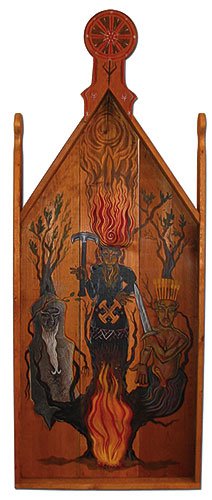Your Legal Resource
Heidnischwerk
Heathen Art - A Reluctant Manifesto
I chose 'reluctant' because this exhibit is not a presentation of a movement or new ism or genre, nor are these notes meant to be a 'program' for their work. The common denominator of the artists represented here is that most of them are spiritually aligned with what can be called the heathen path, which was bound to manifest in their work.
Thus, the choice behind the exhibition title is simple: this collection of artists has decided, in art as in life, to turn away from the dominant monotheisms of our day and to reconsider the worth of the old religions and folkways of Europe. This means discovering societal forms that knew no separation between the religious and secular, where, at the highest level, spirit and action were one. These societies were also characterized by a religious variety that is unknown today, manifesting in local cults and variances. Yet at the center of these cultures lies the same cyclical view of the world in which the tides of the seasons are celebrated in festival, and in which, at the end of an age, a new world will inevitably arise from the old.
Just as there was no separation between art and life, there was not yet a distinction between fine art and crafts - all creative activity was an expression of the skill and soul of the creator. Ornamentation and iconography were filled with symbolic significance. And much of the artistic practice was specifically informed by religious and/or magical concerns. These same motivations are obviously embraced by at least some of the artists in this exhibit.
This preoccupation with pre-Christian motifs and art has its precedents. Artists as far back as the Classicists and certainly the Romantics found inspiration in newly rediscovered texts such as the Eddas and the Nibelungenlied. In the second half of the 19th century, National Romantic movements swept most of Europe and inspired a new examination of native myths and the value of folk art. This paved the way for Art Noveau's adaptation of ancient ornament, and the Symbolist penchant for the bizarre and mystical led to some of the most memorable images of gods and goddesses, myths, and fairy tales.
Just as the best Symbolist and Surrealist artists, the 'new heathen' artists champion content and intent rather than style and mannerism. To them, the past is a guide that animates the present and each work completes a cycle of learning and discovery. This includes a healthy respect for traditional skills and craftsmanship.
Henry Corbin, in his work Recovering a Visionary Geography, wrote: "that we must abandon homogeneous chronological time in order to enter that qualitative time which is the history of the soul." In my mind, this is precisely the state that would be most conducive to tapping into the works presented here.
